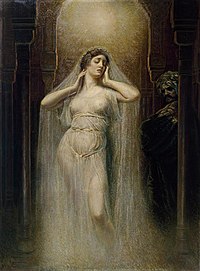72:
157:
164:
When the "Asociación
Wagneriana de Madrid" was established in 1911, he presented them with copies of voice and piano versions of several operas and one hundred etchings of his portrait of Wagner (based on a familiar photograph), to be sold to benefit the association. Later, he was made an honorary
22:
108:, where he introduced himself to Wagner and became his friend. In the following years, he and Wagner got together again several times: in Venice (1880), Berlín (1881), and Bayreuth (1882), where he was a guest at the premiere of
117:
After his first meeting with Wagner, he decided to devote his career to doing works on
Wagnerian themes, mostly portraits of the characters rather than specific scenes. During his visits to Germany, he also created portraits of
168:
He remained in Paris until 1914, when World War I forced him to return to Spain. He died in Madrid the following year. From 2013 to 2014, in celebration of Wagner's 200th birthday, the
172:
presented an exhibition of
Egusquiza's works called "El Mal se desvanece" (Evil fades), which included several portraits of classical literary figures as well as his Wagnerian works.
265:
149:, winning a silver medal. Although he lived in Paris, he was a frequent visitor to Madrid and was part of a circle of Wagnerian admirers that met at the
57:
98:
He heard Wagner's music for the first time in 1876, after returning to Paris. Three years later, he travelled to Munich to hear a performance of
297:
322:
312:
302:
247:
317:
307:
208:
146:
100:
137:
191:
327:
260:
92:
53:
239:
32:(1845 – 10 February 1915) was a Spanish painter, known for his friendship with the German composer
128:
60:, he returned to Paris and settled there. At first, he painted historical scenes, but later turned to
292:
287:
224:
123:
119:
71:
88:
156:
84:
80:
169:
236:
Richard Wagner (1813-1983) et
Rogelio d’Egusquiza (1845-1915): Correspondances des arts
49:
33:
281:
243:
91:, taking Fortuny's place at their studio through 1875 and attending classes at the
45:
271:
65:
61:
56:
in Paris. In 1868, after travelling and participating several times in the
21:
110:
105:
150:
70:
132:
called "Über die
Beleuchtung der Bühne" (On Stage Lighting).
268:
by Jordi Mota and María
Infiesta @ Archivo Richard Wagner.
48:, into a well-to-do family. He studied in Madrid and with
141:
in 1892, 1893, 1896 and 1897, and presented prints from
83:, he moved to Rome at the invitation of the Madrazos,
104:. His enthusiasm for what he heard led him to go to
266:"Rogelio de Egusquiza, un Pintor Amigo de Wagner"
36:, whose works he helped make familiar in Spain.
8:
25:Rogelio de Egusquiza with a bust of Wagner
155:
126:and wrote an article for the newsletter
20:
229:Rogelio de Egusquiza. Pintor y grabador
181:
7:
204:
202:
200:
187:
185:
14:
261:ArtNet: More works by Egusquiza.
58:National Exhibition of Fine Arts
234:María Ángeles Lobera Vizcaino,
30:Rogelio de Egusquiza y Barrena
1:
298:19th-century Spanish painters
147:Exposition Universelle (1900)
64:scenes and portraits in the
323:Spanish emigrants to France
194:@ Cantabria 102 Municipios.
18:Spanish painter (1845–1915)
346:
101:The Ring of the Nibelungen
313:Spanish portrait painters
303:19th-century male artists
138:Salons de la Rose + Croix
135:He participated in the
93:Spanish Academy in Rome
79:Following the death of
318:Artists from Cantabria
248:Biblioteca Complutense
240:University of Toulouse
211:@ the Museo del Prado.
161:
122:(posthumous) and King
76:
44:Egusquiza was born in
26:
308:Spanish male painters
272:Articles on Egusquiza
159:
74:
24:
225:Aureliano de Beruete
124:Ludwig II of Bavaria
54:École des Beaux-Arts
238:, Master's thesis,
231:, Blass y Cía, 1918
120:Arthur Schopenhauer
162:
129:Bayreuther Blätter
77:
27:
335:
212:
206:
195:
189:
345:
344:
338:
337:
336:
334:
333:
332:
278:
277:
257:
221:
219:Further reading
216:
215:
209:Brief biography
207:
198:
192:Brief biography
190:
183:
178:
170:Museo del Prado
42:
19:
12:
11:
5:
343:
342:
339:
331:
330:
328:Richard Wagner
325:
320:
315:
310:
305:
300:
295:
290:
280:
279:
276:
275:
269:
263:
256:
255:External links
253:
252:
251:
232:
220:
217:
214:
213:
196:
180:
179:
177:
174:
41:
38:
34:Richard Wagner
17:
13:
10:
9:
6:
4:
3:
2:
341:
340:
329:
326:
324:
321:
319:
316:
314:
311:
309:
306:
304:
301:
299:
296:
294:
291:
289:
286:
285:
283:
274:@ Foro Xerbar
273:
270:
267:
264:
262:
259:
258:
254:
249:
245:
241:
237:
233:
230:
226:
223:
222:
218:
210:
205:
203:
201:
197:
193:
188:
186:
182:
175:
173:
171:
166:
158:
154:
152:
148:
144:
140:
139:
133:
131:
130:
125:
121:
115:
113:
112:
107:
103:
102:
96:
94:
90:
86:
82:
81:Marià Fortuny
73:
69:
67:
63:
59:
55:
51:
47:
39:
37:
35:
31:
23:
16:
235:
228:
167:
163:
153:restaurant.
142:
136:
134:
127:
116:
109:
99:
97:
78:
46:El Astillero
43:
29:
28:
15:
293:1915 deaths
288:1845 births
50:Léon Bonnat
282:Categories
176:References
246:from the
40:Biography
165:member.
143:Parsifal
111:Parsifal
106:Bayreuth
85:Raimundo
75:Parsifal
66:Academic
242:, 2000
145:at the
89:Ricardo
68:style.
52:at the
244:Online
160:Kundry
151:Lhardy
62:genre
87:and
284::
227:,
199:^
184:^
114:.
95:.
250:.
Text is available under the Creative Commons Attribution-ShareAlike License. Additional terms may apply.


